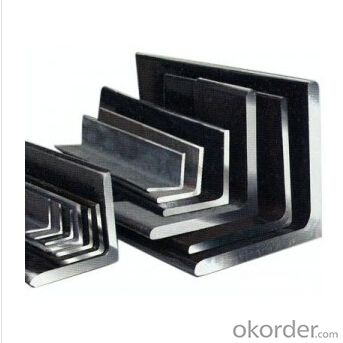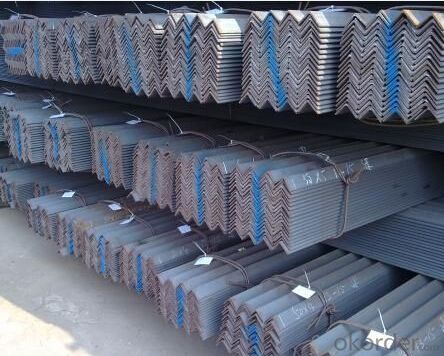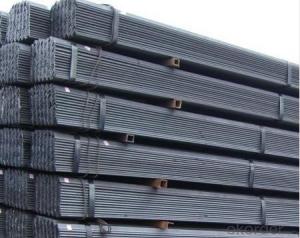GB235/275 A36 Angle Steel
- Loading Port:
- China Main Port
- Payment Terms:
- TT or LC
- Min Order Qty:
- -
- Supply Capability:
- -
OKorder Service Pledge
OKorder Financial Service
You Might Also Like
Product Description:
OKorder is offering GB235/275 A36 Angle Steel at great prices with worldwide shipping. Our supplier is a world-class manufacturer of steel, with our products utilized the world over. OKorder annually supplies products to European, North American and Asian markets. We provide quotations within 24 hours of receiving an inquiry and guarantee competitive prices.
Product Applications:
GB235/275 A36 Angle Steel are ideal for structural applications and are widely used in the construction of buildings and bridges, and the manufacturing, petrochemical, and transportation industries.
Product Advantages:
OKorder's GB235/275 A36 Angle Steel are durable, strong, and resist corrosion.
Main Product Features:
· Premium quality
· Prompt delivery & seaworthy packing (30 days after receiving deposit)
· Corrosion resistance
· Can be recycled and reused
· Mill test certification
· Professional Service
· Competitive pricing
Specifications of GB235/275 A36 Angle Steel
1. Standards: GB,ASTM,BS,AISI,DIN,JIS
2. Invoicing on theoretical weight or actual weight as customer request
3. Material:Material: GB Q235B, Q345B or Equivalent; ASTM A36; EN 10025, S235JR, S355JR; JIS G3192, SS400; SS540.
4. Sizes:
Sizes: 25mm-250mm | ||
a*t | ||
25*2.5-4.0 | 70*6.0-9.0 | 130*9.0-15 |
30*2.5-6.6 | 75*6.0-9.0 | 140*10-14 |
36*3.0-5.0 | 80*5.0-10 | 150*10-20 |
38*2.3-6.0 | 90*7.0-10 | 160*10-16 |
40*3.0-5.0 | 100*6.0-12 | 175*12-15 |
45*4.0-6.0 | 110*8.0-10 | 180*12-18 |
50*4.0-6.0 | 120*6.0-15 | 200*14-25 |
60*4.0-8.0 | 125*8.0-14 | 250*25 |
5. Material details:
Alloy No | Grade | Element (%) | |||||
C | Mn | S | P | Si | |||
|
|
|
|
|
|
| |
Q235 | B | 0.12—0.20 | 0.3—0.7 | ≤0.045 | ≤0.045 | ≤0.3 | |
|
|
|
|
|
|
| |
Alloy No | Grade | Yielding strength point( Mpa) | |||||
Thickness (mm) | |||||||
≤16 | >16--40 | >40--60 | >60--100 | ||||
≥ | |||||||
|
|
|
|
|
| ||
Q235 | B | 235 | 225 | 215 | 205 | ||
Alloy No | Grade | Tensile strength (Mpa) | Elongation after fracture (%) | ||||
Thickness (mm) | |||||||
| ≤16 | >16--40 | >40--60 | >60--100 | |||
≥ | |||||||
|
|
|
|
|
|
| |
Q235 | B | 375--500 | 26 | 25 | 24 | 23 | |
Usage & Applications of GB Q235 Angle Steel
Trusses;
Transmission towers;
Telecommunication towers;
Bracing for general structures;
Stiffeners in structural use.
Packaging & Delivery of GB Q235 Angle Steel
1. Transportation: the goods are delivered by truck from mill to loading port, the maximum quantity can be loaded is around 40MTs by each truck. If the order quantity cannot reach the full truck loaded, the transportation cost per ton will be little higher than full load.
2. With bundles and load in 20 feet/40 feet container, or by bulk cargo, also we could do as customer's request.
3. Marks:
Color mark: There will be color marking on both end of the bundle for the cargo delivered by bulk vessel. That makes it easily to distinguish at the destination port.
Tag mark: There will be tag mark tied up on the bundles. The information usually including supplier logo and name, product name, made in China, shipping marks and other information request by the customer.
If loading by container the marking is not needed, but we will prepare it as customer request.
FAQ:
Q1: Why buy Materials & Equipment from OKorder.com?
A1: All products offered byOKorder.com are carefully selected from China's most reliable manufacturing enterprises. Through its ISO certifications, OKorder.com adheres to the highest standards and a commitment to supply chain safety and customer satisfaction.
Q2: How do we guarantee the quality of our products?
A2: We have established an advanced quality management system which conducts strict quality tests at every step, from raw materials to the final product. At the same time, we provide extensive follow-up service assurances as required.
Q3: How soon can we receive the product after purchase?
A3: Within three days of placing an order, we will begin production. The specific shipping date is dependent upon international and government factors, but is typically 7 to 10 workdays.


- Q:How do you determine the appropriate size of steel angle for a specific application?
- To determine the appropriate size of steel angle for a specific application, factors such as the load it needs to bear, the length of the span, the type of material being supported, and any applicable building codes or regulations should be considered. Structural engineers or professionals with expertise in steel construction can perform calculations and analysis to determine the required size of steel angle based on these factors.
- Q:How do you store steel angles?
- Steel angles have various storage options depending on space availability and quantity. Here are a few commonly used techniques: 1. Vertical Storage: To store steel angles vertically, they can be leaned against a wall or placed on a storage rack. This method works well for smaller quantities, allowing easy access to each angle. It is crucial to ensure stability and secure positioning to prevent accidents. 2. Horizontal Storage: For larger quantities, steel angles can be stored horizontally. This can be achieved by stacking them on a pallet or using a compartmentalized storage rack. When stacking, it is important to evenly distribute the weight and use spacers between angles to prevent deformation. 3. Bundled Storage: When dealing with a large number of steel angles, bundling them together can be a convenient storage method. This involves tying the angles with steel strapping or using banding equipment. Bundling helps maintain organization and prevents shifting or falling during storage or transportation. Regardless of the chosen storage method, the following points should be considered: - Provide a clean and dry storage area to prevent rust or corrosion. - Ensure proper ventilation to avoid moisture buildup. - Keep angles away from direct sunlight and extreme temperature changes. - Regularly inspect for damage or corrosion. - Use appropriate lifting equipment and follow safety guidelines when moving or stacking steel angles.
- Q:Can steel angles be used for framing or supporting partitions?
- Yes, steel angles can be used for framing or supporting partitions. Steel angles are commonly used in construction due to their strength and durability. They provide excellent support and stability, making them suitable for framing or supporting partitions in various structures.
- Q:How do you determine the required thickness of a steel angle for a specific load?
- Several factors need to be taken into account in order to determine the necessary thickness of a steel angle for a specific load. Firstly, it is essential to establish the load that will be exerted on the steel angle. This can be achieved by examining the structural design or intended purpose of the steel angle. The load may be either static, such as the weight of a structure, or dynamic, like the force from moving objects or wind. Once the load is known, the subsequent step involves calculating the bending moment and shear force that the steel angle will endure. The bending moment measures the degree of flexing or bending of the steel angle under the applied load, while the shear force measures the internal forces acting parallel to the cross-sectional area. Typically, engineering principles and formulas such as the moment of inertia and maximum stress formula are employed to calculate the bending moment and shear force. These calculations consider the dimensions of the steel angle, the applied load, and the properties of the steel material. Once the bending moment and shear force are determined, the required thickness of the steel angle can be calculated. This calculation necessitates the selection of an appropriate safety factor, which accounts for uncertainties and potential variations in the applied load or the strength of the steel material. The safety factor is typically determined by industry standards or codes. Using the maximum stress formula, which relates the bending moment, shear force, and dimensions of the steel angle to the stress experienced by the material, the required thickness can be calculated. By rearranging the formula, the necessary thickness can be solved for, ensuring that the steel angle is sufficiently strong to withstand the applied load without failure or deformation. To summarize, determining the necessary thickness of a steel angle for a specific load involves analyzing the load, calculating the bending moment and shear force, selecting a safety factor, and utilizing the maximum stress formula to solve for the required thickness. It is crucial to consult engineering principles, codes, and standards to ensure that the steel angle is appropriately sized to withstand the applied load.
- Q:Can steel angles be used in electrical grounding applications?
- Yes, steel angles can be used in electrical grounding applications. Steel angles are commonly used in construction for their strength and durability. In electrical grounding applications, steel angles can be used to create grounding grids or grounding systems. These grids or systems help to prevent electrical shock hazards by providing a low-resistance path for electrical currents to flow to the ground. Steel angles are often used as structural components in these grounding systems due to their ability to withstand physical stress and their conductive properties. However, it is important to ensure that the steel angles are properly installed and connected to the electrical system in accordance with relevant codes and standards to ensure effective grounding and safety.
- Q:What are the common thicknesses of steel angles?
- The common thicknesses of steel angles vary depending on the specific application and industry requirements. However, some commonly used thicknesses for steel angles include 1/8 inch, 3/16 inch, 1/4 inch, 3/8 inch, and 1/2 inch. These thicknesses are often used in construction, manufacturing, and structural applications. It is important to note that thicker steel angles provide increased strength and durability, while thinner angles are suitable for lighter applications. The choice of thickness ultimately depends on the specific load-bearing requirements and structural design considerations.
- Q:How do you determine the required angle thickness for a specific application?
- To determine the necessary thickness of an angle for a particular application, multiple factors must be taken into account. First and foremost, one must understand the load or force that will be placed on the angle. This can be achieved by analyzing the specific application and estimating the weight or pressure that will be exerted on the angle. Next, the material of the angle must be considered. Different materials possess varying strength properties, and their ability to withstand the applied load will differ accordingly. It is crucial to select a material that possesses the necessary strength and durability for the application at hand. Alongside this, the length of the angle and the distance between its supports should also be considered. Longer angles or greater distances between supports may necessitate thicker angles to prevent buckling or bending when subjected to the applied load. Furthermore, environmental factors like temperature, humidity, or corrosive substances may impact the required thickness of the angle. For example, in corrosive environments, a thicker angle may be essential to ensure its longevity and structural integrity. Finally, it is imperative to consult applicable building codes, regulations, or industry standards to ensure compliance and safety. These guidelines often provide specific recommendations or requirements for angle thickness based on the intended application. In conclusion, determining the required angle thickness for a specific application entails analyzing the load, material strength, length, support distance, environmental factors, and relevant regulations. Proper consideration of these factors will help guarantee that the angle can withstand the applied load and provide a safe and durable solution for the given application.
- Q:What are the different surface finishes available for steel angles?
- There are several surface finishes available for steel angles, depending on the specific application and desired aesthetic. Some of the most common surface finishes for steel angles include: 1. Mill finish: This is the standard finish straight from the mill, with a smooth and clean surface. It is the most basic finish and is often used when appearance is not a significant factor. 2. Hot-dip galvanized: This finish involves immersing the steel angles in a bath of molten zinc, which creates a protective coating. It provides excellent corrosion resistance and is commonly used in outdoor or high-moisture environments. 3. Powder coated: In this process, a dry powder coating is applied electrostatically to the steel angles and then cured under heat. Powder coating offers a durable and attractive finish, with a wide range of colors and textures available. 4. Painted: Steel angles can also be painted with various types of paint, such as epoxy, enamel, or acrylic. Painting provides an additional layer of protection against corrosion and allows for customization in terms of color and appearance. 5. Stainless steel: Steel angles can be manufactured using stainless steel, which inherently provides a corrosion-resistant surface finish. Stainless steel angles are often used in applications where hygiene, durability, and aesthetic appeal are important, such as in food processing or architectural projects. 6. Shot blasting: This process involves propelling small steel shots at high velocity onto the surface of the angles. Shot blasting removes mill scale, rust, and other impurities, resulting in a clean, roughened surface that improves adhesion for subsequent coatings or paints. These are just a few examples of the different surface finishes available for steel angles. The choice of finish depends on factors such as the intended use, environmental conditions, desired appearance, and budget. It is important to consult with a steel supplier or manufacturer to determine the most suitable surface finish for a specific application.
- Q:Can steel angles be used for temporary or removable structures?
- Steel angles, known for their versatility, find frequent use in construction for a range of purposes, including temporary or removable structures. They serve as framing components in scaffolding, support structures, and temporary partitions. Thanks to their ability to provide structural support and stability, steel angles prove ideal for temporary or removable structures that demand strength and durability. Moreover, their straightforward assembly and disassembly facilitate convenient installation and removal of such structures.
- Q:Are steel angles resistant to pests and insects?
- Yes, steel angles are resistant to pests and insects as they are not a food source and provide no habitat for them.
1. Manufacturer Overview |
|
|---|---|
| Location | |
| Year Established | |
| Annual Output Value | |
| Main Markets | |
| Company Certifications | |
2. Manufacturer Certificates |
|
|---|---|
| a) Certification Name | |
| Range | |
| Reference | |
| Validity Period | |
3. Manufacturer Capability |
|
|---|---|
| a)Trade Capacity | |
| Nearest Port | |
| Export Percentage | |
| No.of Employees in Trade Department | |
| Language Spoken: | |
| b)Factory Information | |
| Factory Size: | |
| No. of Production Lines | |
| Contract Manufacturing | |
| Product Price Range | |
Send your message to us
GB235/275 A36 Angle Steel
- Loading Port:
- China Main Port
- Payment Terms:
- TT or LC
- Min Order Qty:
- -
- Supply Capability:
- -
OKorder Service Pledge
OKorder Financial Service
Similar products
New products
Hot products
Related keywords




























